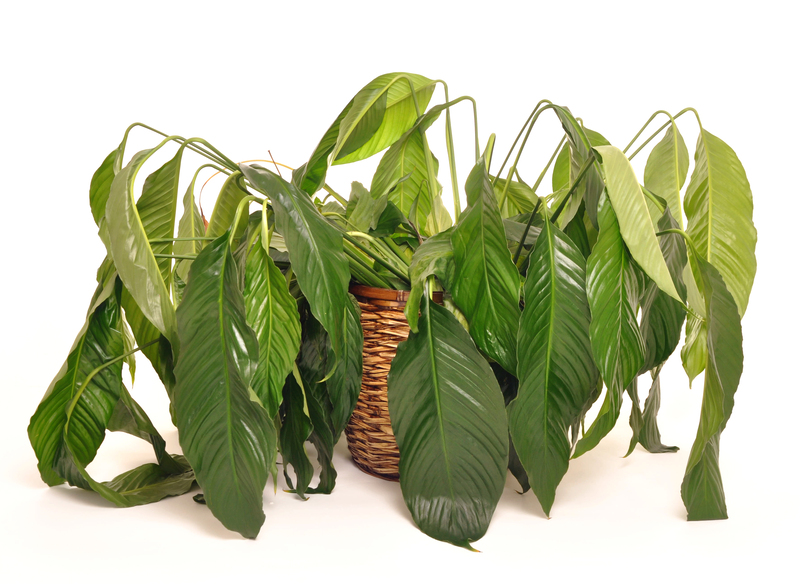Growing Future Solutions: Gardening's Climate-Saving Potential
Posted on 02/09/2025
Growing Future Solutions: Gardening's Climate-Saving Potential
In the face of accelerating climate change, communities and individuals worldwide are searching for actionable ways to make a positive impact. Gardening's climate-saving potential is often overlooked, but it can be a powerful tool in building a greener, more sustainable future. This comprehensive article explores how gardens--of all types and sizes--can address crucial environmental issues while delivering health and social benefits.
Why Gardening Matters for the Planet
Gardening is more than a hobby. It is a climate solution that offers a multitude of sustainability wins, including:
- Reducing greenhouse gases
- Improving biodiversity
- Enhancing soil health
- Conserving water
- Protecting pollinators
- Increasing urban greenery
Home gardens, community plots, and even balcony or rooftop gardens can all serve as important tools to help mitigate climate threats. By understanding the science, making informed choices, and spreading the word, anyone can maximize the climate-saving potential of gardening.

The Science: How Gardens Fight Climate Change
1. Carbon Sequestration in the Soil
Soil plays a crucial role as a carbon sink, drawing in and storing atmospheric carbon dioxide (CO?) through a natural process called carbon sequestration. Healthy, well-managed gardens can contribute by:
- Using organic amendments such as compost, which boosts beneficial microbes and locks carbon in the soil
- Planting trees and perennial shrubs, which absorb and store CO? as they grow
- Practicing no-dig or low-till gardening to maintain soil structure and reduce carbon loss
Fun fact: Studies suggest that one acre of healthy grass or garden soil can store up to 20,000 pounds of carbon per year!
2. Biodiversity Boosters
Diverse gardens replicate mini-ecosystems. Native plants, wildflower meadows, and mixed-species beds support pollinators and wildlife, underpinning ecosystem resilience. Biodiversity is a key part of climate solutions because:
- It reduces the risk of disease and pest outbreaks
- Supports more stable food webs
- Provides habitat for threatened pollinators like bees and butterflies
By prioritizing native and climate-adapted plants, gardeners can help preserve genetic diversity and create climate-ready landscapes.
3. Reducing the Urban Heat Island Effect
Urban areas often suffer from the "heat island effect," where buildings and roads trap heat, raising temperatures significantly. Gardens, trees, and green roofs lower city temps by:
- Shading and cooling the air through evapotranspiration
- Intercepting and absorbing rainfall, reducing local flooding
- Breaking up expanses of concrete, which radiate heat
For cities facing increased heatwaves, urban gardening is a vital adaptation strategy with real-world, measurable impacts.
Climate-Smart Gardening Practices
1. Composting: Recycling for Resilience
Composting kitchen and yard scraps keeps organic matter out of the landfill--where it would otherwise create methane, a potent greenhouse gas. Instead, compost strengthens garden soil, feeding plants and boosting carbon capture.
- Start a compost pile or bin using fruit/veggie peels, coffee grounds, and yard waste
- Avoid adding meat, dairy, or oil, which can attract pests
- Turn your compost regularly for aeration and speedier decomposition
Healthy composting can cut your household's carbon footprint by hundreds of pounds per year!
2. Choosing Climate-Resilient Plants
Selecting plants adapted to your local climate leads to gardens that thrive with minimal water and chemical inputs. Try these steps:
- Plant native species that evolved locally--these often need less care and support local wildlife
- Use drought-tolerant flowers, herbs, and shrubs when water conservation is needed
- Mix annuals and perennials for stable, year-round cover
Climate-smart plant choices make gardens more productive, beautiful, and sustainable over the long term.
3. Smart Water Management
Gardens can either stress or relieve local water resources. To make your garden water-smart:
- Install rain barrels to catch and reuse roof runoff
- Add a layer of organic mulch to suppress weeds and retain moisture
- Practice drip irrigation for targeted watering with zero waste
These methods save water, reduce erosion, and help gardens persist during droughts--key as climate extremes increase.
4. Reducing Chemical Inputs
Pesticides and synthetic fertilizers have costs: water pollution, reduced soil health, and greenhouse gas emissions. Organic gardening techniques, like crop rotation, companion planting, and attracting beneficial insects, keep gardens healthy without chemicals.
5. Planting Trees and Perennials
Trees and shrubs store carbon for decades while providing wildlife shelter and shade. Planting a single tree can offset tons of carbon over its life, cool your yard, and require less replanting versus annuals.
Gardening for Food Security, Nutrition, and Resiliency
Growing food is a powerful step toward resilient, local food systems that emit fewer climate-harming gases. Food gardens:
- Slash the emissions from packaging and shipping produce long distances
- Allow reuse of kitchen and yard scraps as compost, forming a closed nutrient loop
- Provide fresher, more nutritious food
- Teach communities about seasonal eating and sustainable agriculture
Adopting climate-saving gardening practices can empower communities to weather disruptions and eat healthier, local food.
Emerging Solutions: Vertical and Urban Gardening
In cities where space is at a premium, innovative gardening models such as vertical gardens, rooftop gardens, and hydroponic systems are expanding the reach of gardening's climate solution. Benefits include:
- Capturing and filtering urban carbon and pollutants
- Greening underused spaces
- Local food production in food deserts
Even simple container gardens on balconies can add up to make cities more sustainable and healthy for future generations.
Community Action: Gardening Movements Making a Difference
1. Community Gardens and Urban Farms
Community gardening transforms vacant lots and underutilized public lands into thriving green spaces. These gardens:
- Foster environmental stewardship and collective climate action
- Provide affordable, nutritious produce in urban settings
- Offer educational opportunities for all ages
Joining or supporting a local garden project multiplies the impact of gardening's climate-saving potential, building both stronger communities and healthier ecosystems.
2. Native Plant and Pollinator Initiatives
Grassroots movements that encourage planting native wildflowers, milkweed, and meadow gardens are vital for:
- Supporting monarch butterflies, bees, and other at-risk species
- Restoring natural cycles disrupted by climate change
- Inspiring neighbors and schools to join the climate gardening movement
Such initiatives showcase the power of gardens to make meaningful environmental changes on a landscape scale.
Gardening for Climate: Tools and Resources
Whether you are an expert horticulturist or a total beginner, resources abound to strengthen your climate-friendly gardening skills. Explore:
- Local native plant societies for guidance on regionally-adapted plant selections
- Cooperative extension services offering free or low-cost workshops on composting, water conservation, and pest management
- Online forums and garden apps where you can connect with likeminded gardeners in your area
- Seed swap events and plant shares, building biodiversity and community
Seeking expert advice and continually learning allows gardeners everywhere to maximize their climate impact.
The Broader Benefits of Climate-Saving Gardening
While gardening's climate potential is impressive, there are significant co-benefits to consider:
- Improved mental and physical health: Time spent outdoors and among plants reduces stress, encourages movement, and fosters happiness
- Beautification of neighborhoods, which reduces crime and increases property values
- Educational opportunities for youth and adults, leading to lifelong environmental stewardship
- Job creation and economic development through local food and plant production
The ripple effect of climate-positive gardening extends beyond carbon capture, fostering greener, more connected, and more resilient communities.

Getting Started: Your Action Plan for Future-Focused Gardening
1. Assess Your Space
Gardens come in all shapes and sizes. Whether you have a large yard, a modest balcony, or a sunny windowsill, you can contribute! Start by:
- Mapping your available space and sunlight levels
- Choosing containers, raised beds, or patches of ground
- Planning for vertical or hanging gardens if horizontal space is limited
2. Plan for Sustainability
Set goals for your garden:
- Will you grow food, flowers, or a mix?
- Do you want to attract specific pollinators or wildlife?
- Can you incorporate water-saving measures or composting?
3. Choose Climate-Wise Plants
- Prioritize native and drought-tolerant varieties
- Avoid invasive species that harm local ecosystems
- Plant trees and perennial shrubs where possible
4. Build Living Soil
Feed your garden from the ground up:
- Use organic amendments (compost, leaf litter, natural mulch)
- Limit synthetic fertilizer and pesticide use
- Try no-dig techniques to preserve carbon-rich soil
5. Connect and Share
- Join local garden groups or climate action networks
- Share seeds, plants, and knowledge with neighbors
- Document your progress to inspire others online
Conclusion: Gardening for a Cooler Climate and Brighter Future
From lush home plots to rooftop beds and city parks, gardens are growing future solutions. Each climate-smart gardener plays a vital role in capturing carbon, bolstering biodiversity, and building resilient communities for generations to come. Whether you're tending a vegetable patch, planting a pollinator meadow, or supporting local green initiatives, your actions matter in the global effort to cool the planet.
Start with one plant, one patch of soil, or one bag of compost--your journey in growing gardening's climate-saving potential begins now.
For further reading:
- Visit your local extension service for region-specific garden tips
- Explore books and websites dedicated to climate-smart and regenerative gardening
- Engage with global gardening movements for inspiration and community
Together, let's cultivate a climate-safe, food-secure, and beautiful world--one garden at a time.

